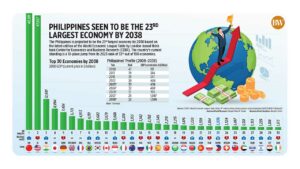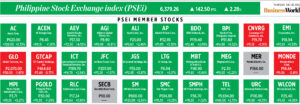No need for BSP to move in tandem with the Fed

By Keisha B. Ta-asan, Reporter
THE BANGKO Sentral ng Pilipinas (BSP) sees the policy moves of the US Federal Reserve carrying less weight in its own decision making as addressing still-elevated domestic inflation is more important, an official said on Thursday.
The actions of the US central bank are now “less of a factor” in the BSP’s policy decisions, BSP Deputy Governor Francisco G. Dakila, Jr. said during the Philippine Economic Briefing held in Singapore on Thursday.
“What the Fed does will remain relevant, but right now, domestic considerations carry more weight. Even if the Fed decides to pause its policy tightening, which it did this morning, we may not move in complete lockstep if the domestic inflation picture warrants a different response,” Mr. Dakila said.
The Federal Open Market Committee decided to keep rates steady at its June 13-14 meeting but signaled that borrowing costs may still need to go higher.
The Fed has increased borrowing costs by 500 basis points to 5-5.25% since March last year. Its next meeting will be on July 25-26.
For its part, the BSP’s policy-setting Monetary Board paused its tightening cycle last month, keeping its benchmark interest rate unchanged at 6.25%.
The BSP has raised rates by 425 bps since May last year.
“Actually, if you read the policy statement of the Monetary Board during their [May 18] policy meeting, it was still quite hawkish and emphasized continued vigilance and the possibility of further adjustments in monetary policy,” Mr. Dakila said.
“With continued elevated price pressures and the risk of a global economic slowdown, the BSP’s top priority is to manage inflation and to help maintain the strength of the economy even as we gear ourselves against headwinds,” he said.
He added that the continued decline in headline inflation in May shows that price pressures are easing.
Headline inflation cooled for a fourth straight month in May to 6.1% from 6.6% in April. Still, it was the 14th straight month that inflation breached the central bank’s 2-4% goal.
Inflation averaged 7.5% for the first five months, higher than the revised 5.5% forecast by the central bank.
Mr. Dakila added that the policy actions of the BSP have been effective in mitigating volatility in the foreign exchange market.
“Through our sustained efforts to combat above-target inflation, the peso has also greatly improved relative to its year-high level last October, following hawkish pronouncement by Fed officials,” he said.
The peso posted a record low of P59 against the dollar in October last year but has since rebounded, trading at the P55 to P56 level recently.
The BSP official added that high interest rates will have a minimal impact on the economy’s gross domestic product (GDP).
“The first-quarter growth was very strong,” Mr. Dakila said. “What we are seeing is that in every 25-bp increase in policy rate, it has a minimal impact on the growth numbers.”
The Philippine economy grew by 6.4% in the first quarter, the slowest in two years. It was also slower than the 8% expansion in the first quarter of 2022.
Meanwhile, analysts said the BSP will continue to keep the benchmark policy rate at 6.25% at its meeting next week following the Fed’s decision.
Former central bank Deputy Governor Diwa C. Guinigundo said the BSP will remain data-driven, but the Fed’s action will be a crucial determinant in monetary stance given how important it is to maintain an interest rate differential with the US policy rate.
“Both central banks are aware that inflation could resurge because of certain wild cards like the oil cutback and possible disorder in the global value chain,” Mr. Guinigundo said in a Viber message.
“In the US, inflation is still uncomfortably elevated while the labor markets remain firm. Thus, the chance of another bout of tightening is not far-fetched. This could also be said here considering that the year-to-date inflation remains in breach of the target while unemployment has sustained its downtrend,” he added.
Consumer prices in the US rose by 4% in May, the slowest in more than two years, easing from April’s 4.9%.
Asked if the BSP could still hike borrowing costs in the coming months, Mr. Guinigundo said: “If inflation shoots up and the peso acts up again, there is a good possibility the Monetary Board might consider the possibility of another rate adjustment.”
Metropolitan Bank & Trust Co. (Metrobank) said in a report that the Fed is dealing with “stickier” inflation, while the BSP is seeing a continued downward trend in the average rise in prices.
“After narrowly skirting the debt ceiling crisis in early June, US authorities can focus back on the inflation problem. At its policy meeting today, however, it made a pause on hiking its rates, but surprised with a forecast of two more quarter-point hikes in its economic projections this year,” the bank said.
However, if the Fed hikes again in the coming months, the BSP may not match every move of the US central bank the way it did last year as the country’s dollar reserves are strong enough to manage market volatility.
Central bank data showed gross international reserves slipped by 0.5% to $101.3 billion in May from the April level.
Year on year, reserves declined by 2.3%.
BSP Governor Felipe M. Medalla earlier said the Monetary Board may keep policy rates unchanged until the third quarter. Its next three policy meetings are scheduled on June 22, Aug. 17 and Sept. 21




